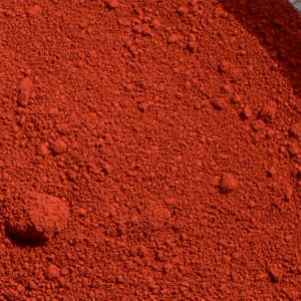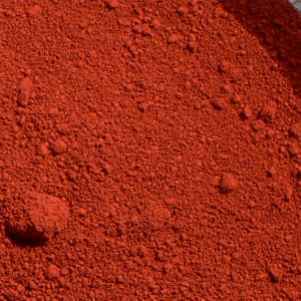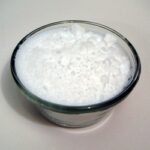Iron Oxide Red ( Natural )
We are the stalwarts in the domain of manufacturing, supplying, wholesaling and exporting Iron Oxide Red ( Natural ) These flavor grade chemicals are processed using pure and accurate ingredients that procured from reliable and trusted vendors of the market. Our range is available in the market at leading prices in packs of different quantities.
Iron Oxide Red (natural), also known as hematite, is a naturally occurring mineral pigment that has several uses and applications in agriculture.
Here are some of the common uses and applications of iron oxide red in agriculture:
Soil Amendment: Iron oxide red can be used as a soil amendment to improve soil quality. It can help increase the nutrient-holding capacity of the soil and improve its structure. This can be particularly beneficial in sandy soils, which tend to have poor nutrient retention.
pH Adjustment: Hematite can be used to adjust soil pH. If the soil is too acidic (low pH), iron oxide red can help raise the pH towards a more neutral range. This can make the soil more suitable for a wider range of crops.
Colorant: Iron oxide red is often used as a colorant in agricultural products such as mulch, fertilizer coatings, and animal feed. It can provide a reddish color to these products, which can be aesthetically pleasing and help with product identification.
Seed Coating: Iron oxide red can be used as a seed coating material. Coating seeds with iron oxide red can help improve their visibility during planting and can also provide some protection against fungal and bacterial diseases.
Pigment in Fertilizers: It can be used as a pigment in fertilizers to give them a reddish color. This can make it easier for farmers to see where the fertilizer has been applied and ensure even distribution.
Anti-Caking Agent: Iron oxide red can be added to fertilizers and soil amendments as an anti-caking agent. It helps prevent clumping and ensures that the product can be easily spread and applied.
Trace Element Source: Iron is an essential trace element for plants, and iron oxide red can serve as a source of iron in soil. It slowly releases iron into the soil, making it available to plants over time.
Algae Control: In aquatic agriculture or aquaculture, iron oxide red can be used to control algae growth. When applied to water bodies, it can help reduce algae blooms by limiting the availability of nutrients that algae need to thrive.
Environmental Remediation: In some cases, iron oxide red can be used for environmental remediation in agricultural areas. It can help adsorb and remove heavy metals and contaminants from soil and water, improving environmental conditions for farming.
It’s important to note that while iron oxide red has various applications in agriculture, its use should be carefully considered based on soil and crop needs, and application rates should be determined through soil testing and consultation with agricultural experts. Additionally, local regulations and guidelines should be followed when using iron oxide red in agriculture to ensure its safe and effective use.
Iron oxide red (natural), or hematite, has a wide range of uses and applications beyond agriculture. Here, I’ll elaborate on its various applications in different industries:
Construction and Building Materials:
Pigments: Hematite is commonly used as a pigment in the construction industry. It provides a reddish-brown color to concrete, paints, coatings, and bricks. It’s often used for decorative and aesthetic purposes.
Paints and Coatings:
Corrosion Protection: Hematite is added to primers, paints, and coatings for its anti-corrosion properties. It acts as a barrier, preventing oxygen and moisture from reaching metal surfaces, thus reducing rust and corrosion.
Plastics and Polymers:
Colorant: Iron oxide red is used as a colorant in plastics and polymers to achieve various shades of red and brown. It’s particularly valuable in the production of plastic products like toys, containers, and automotive parts.
Cosmetics and Personal Care:
Pigments: Hematite is used in cosmetics, such as lipstick, eyeshadow, and nail polish, for its deep red color. It adds vibrancy and appeal to cosmetic products.
Magnetic Recording Media:
Magnetic Tapes: Hematite has magnetic properties and has been used in the past for magnetic recording media, like audio and video tapes.
Wastewater Treatment:
Adsorbent: Hematite can be employed as an adsorbent in wastewater treatment to remove heavy metals and pollutants. Its surface properties make it effective for binding to contaminants.
Catalysis:
Catalyst Support: Hematite nanoparticles can serve as a support material for catalytic reactions. They can enhance the catalytic activity of various catalysts, making them more efficient.
Healthcare and Medicine:
MRI Contrast Agents: Hematite nanoparticles are explored for use in magnetic resonance imaging (MRI) as contrast agents. They can improve the visibility of specific tissues or structures in the body.
Energy Storage:
Lithium-Ion Batteries: Hematite is studied as a potential electrode material in lithium-ion batteries due to its high theoretical capacity and low cost. However, it faces challenges in terms of low electrical conductivity.
Environmental Remediation:
Water Purification: Hematite nanoparticles can be employed for the removal of pollutants and heavy metals from water sources, contributing to environmental cleanup efforts.
Jewelry and Gemstones:
Gemstone: Although not as common as other gemstones, hematite is occasionally used in jewelry for its metallic luster and unique appearance. It’s often polished and used as beads or cabochons.
Education and Research:
Educational Demonstrations: Hematite specimens are used in educational settings to demonstrate magnetic properties and the principles of mineralogy.
Fireworks and Pyrotechnics:
Colorant: Hematite is sometimes used in fireworks compositions to produce red and brown colors in pyrotechnic displays.
These diverse applications highlight the versatility of iron oxide red (hematite) in various industries. Its properties, including its color, magnetic nature, and adsorption capabilities, make it a valuable material in both industrial and consumer products.






